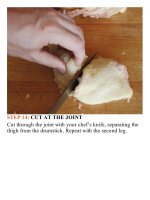The food lab better home cooking through science ( PDFDrive ) 230
Bạn đang xem bản rút gọn của tài liệu. Xem và tải ngay bản đầy đủ của tài liệu tại đây (133.65 KB, 2 trang )
sweeterones.Second,enzymaticreactionsthatcreatesimple
sugarsareacceleratedwithheat.
Step2:ChooseYourAromatics
Alliums—onions, leeks, shallots, garlic, and the like—are
liketheBestSupportingActorofthesouppot.They’renot
there to steal the spotlight, but without them, your soup
wouldbeboring.NearlyeverysoupImakestartswitheither
onions or leeks, along with some garlic or shallot (and
sometimesallfour!)cookeddowninoliveoilorbutter.
Otherfirmvegetablessuchasdicedcarrots,bellpeppers,
celery, thinly sliced fennel, or ginger can work well in
certainsituations,buttheytendtohaveastrongerimpacton
thefinishedflavorofthedish,somakesurethatyoureally
want them there. Make a carrot soup with just onions and
it’lltastelikecarrotsoup.Makeacarrotsoupwithfennelor
ginger,anditwilltastelikecarrot-and-fennelsouporcarrotand-gingersoup.
Step3:SweatorBrownYourAromatics
Nextbigquestion:tosweatortobrown?
• Sweating is the process of slowly cooking chopped
vegetablesinafat.Youdoitovermoderateheat,andthe
goal is to get rid of some of the excess moisture within
those vegetables, and to break down their cellular
structure so that their flavor is released.With the case of
alliums,there’sanotherprocessgoingon:onionaromais
createdwhencertainprecursormoleculesthatexistwithin
separate compartments in onion cells break out and
combine with each other. Sweating an onion will break
down cell walls, allowing this process to happen. The
sameholdstrueforgarlic,shallots,andleeks.
• Browning starts out like sweating, but generally
takes place over higher heat. Once excess liquid from
vegetables has evaporated, the vegetables can begin to
brown and caramelize, creating rich flavors, more sweet
notes, and more complexity. You might think that more
flavorisalwaysbetter,andthusyoushouldalwaysbrown
your vegetables, but more often than not, this browning
can be overpowering, making soups too sweet or
competingtoomuchwiththesubtlerflavorsofyourmain
vegetable.
Step4:AddSecond-LevelAromaticsLikeSpicesand
Pastes
After your aromatics have sweated or browned, the next
phaseisyoursecondaryaromatics,andit’sanoptionalstage
that’s often omitted. If you like very clean, pure-tasting
soups, jump ahead. If you like playing with flavors and
spices,thenyou’llhavefunwiththisstep.
These are things like ground spices (say, curry powder,
ground cumin, or chili powder) and moist pastes (like
tomatopaste,harissa,orchoppedchipotlepeppersinadobo
sauce). These types of ingredients benefit from a brief
toasting or frying in hot oil, which alters some of their
constituentsintomorecomplex,morearomaticproducts,as
well as extracting fat-soluble flavors so that they disperse
moreevenlyintothesoup.
Because ground spices have such a high ratio of surface









